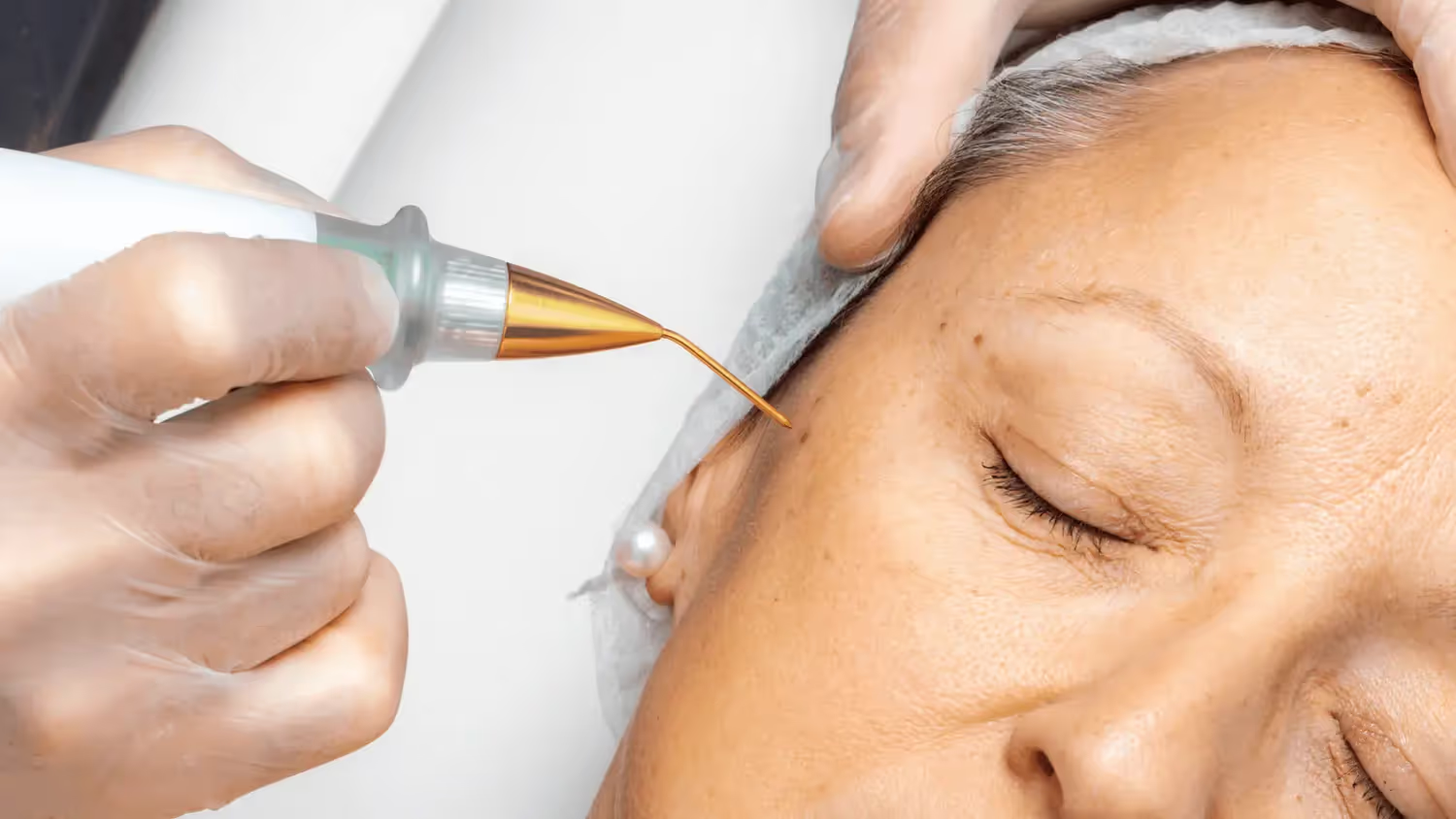In recent years, TikTok has been the go-to source for game-changing beauty hacks, and one such TikTok superstar is Plasma Fibroblast Therapy, a.k.a. plasma pen! It’s a much sought-after medical aesthetic treatment, especially effective when professional hands at a med spa are administering it.
Individuals everywhere want convenient solutions for enhancing their looks, making non-invasive procedures like Plasma Fibroblast therapy an ideal option.
While Botox and other neuromodulators top the charts when it comes to the most-loved aesthetic treatment offered by med spas, many people are opting for plasma fibroblast therapy for its longer-lasting effects.
Fibroblast skin tightening technology owes much of its current popularity to TikTok. Hashtags like #plasmapen, #fibroblastplasma, or #fibroblastplasmapen demonstrate countless patient experiences and client reviews about the procedure.
However, it is not safe to self-administer this procedure. Only medical professionals under clinical supervision should perform these treatments to ensure safety and avoid adverse effects. This makes plasma fibroblast an ideal candidate treatment for you to offer at your med spa.
This article will outline the basics of plasma fibroblast therapy, how it works, who can offer/administer it as a treatment, and the potential profitability of the procedure.
- Related article: Staying Ahead of the Game: 10 Most Popular Medical Aesthetic Procedures
What is Plasma Fibroblast Therapy?
Plasma fibroblast therapy is a relatively new non-invasive aesthetic procedure that uses energy to create high temperature plasma to tightens and enhances the skin. Many see it as a great alternative to laser, surgical, and injection procedures.
Other names for this treatment include:
- plasma skin resurfacing
- plasma skin regeneration
- plasma pen
- fibroblasting
- plasma needling
- plasma lift
In plasma fibroblast treatment, a sterile, disposable probe called a plasma pen discharges energy in the form of plasma, a gas-like substance with high heat.
During the procedure, medical professionals release a very targeted, high-frequency current onto small areas of the skin. The plasma creates microscopic holes (about 1 to 2 millimeters) or micro-injuries on the skin’s surface.
The skin tissue absorbs the heat from the plasma waves, which results in the following:
- immediate skin contraction or tightening
- breakdown of collagen and other proteins
- fibroblast activation
- tissue regeneration
Fibroblasts are cells responsible for collagen formation, essential in wound healing and maintaining the skin’s flexibility and firmness. By activating fibroblasts, the skin heals/rejuvenates itself.
Is Plasma Fibroblast Therapy FDA approved?
Plasma fibroblast devices are considered Class II devices. The FDA generally gives these devices clearance once it determines that these devices are safe and effective for particular use cases based on evidence the manufacturers provide.
So far, several devices have an FDA clearance for the “removal and destruction of skin lesions and coagulation of tissue.” Some of these include:
Meanwhile, the Renuvion/J-Plasma device received approval from the FDA “for the treatment of moderate to severe wrinkles and rhytides, limited to patients with Fitzpatrick skin types I, II or III.” [link]
The FDA warns individuals and healthcare providers against the off-label aesthetic use of similar plasma devices that have been FDA-cleared for “cutting, coagulation, and ablation of soft tissue” in open surgeries and laparoscopic procedures.
If you’re curious whether the product you intend to buy is FDA-cleared for aesthetic procedures, you may check directly from the agency’s 510(k) Premarket Notification database.
What is Plasma Fibroblast Therapy used to treat?
You can use plasma fibroblast therapy to treat a variety of skin concerns. Generally, med spas use this treatment to tighten patient skin and improve wrinkles, fine lines, and loose, sagging skin. It can rejuvenate different areas of the body, including:
- sagging upper eyelids
- eye bags
- crow’s feet
- jowls
- loose or sagging skin on the neck and chest
- nose concerns
- frown lines
- wrinkles, fine lines, and sagging skin anywhere on the face
- loose tummy pooch
A 2020 study found that the procedure is a safe and effective treatment for fine lines and creases in people with Fitzpatrick skin types I to III, with more significant improvements noted in people with higher scores.
It can also “lift” the skin on the arms, knees, thighs, and abdomen.
Aside from tightening the skin, plasma pen can also address other skin problems, such as:
- skin lesions, like warts, skin tags, and moles
- skin pigmentations, like sun spots and age spots
- scars, including post-surgical scars, acne scars, and stretch marks
How long does Plasma Fibroblast Therapy last?
Depending on the treated area, a session typically lasts 30 minutes to an hour or more. The procedure may take time because the medical professional needs to place each dot in a precise, tight, grid-like pattern.
Results are visible immediately, but a person should see the full results one month after the treatment. Its effects are long-lasting, with some patients seeing results for up to three years.
Who can administer Plasma Fibroblast Therapy?
According to the American Board of Cosmetic Surgery, completely non-invasive procedures can be safely administered by licensed nurses or licensed and trained aestheticians under the supervision of a physician.
In a med spa setting, the practice's medical director will need to approve the addition of this treatment and then train all staff to ensure they are administering it safely.
Learn more about who can open a med spa here.
How profitable is Plasma Fibroblast Therapy as a treatment option?
While the cost of the plasma pen devices are not publicly available, the average patient cost of a plasma pen treatment ranges from $600 to $1900, depending on the target area and who is providing treatment.
However, let’s say you charge $600 per treatment. In a year, you’ll potentially add $28,800 in spa revenue if you treat one client each week. Meanwhile, if your clinic performs ten plasma pen treatments every week you’ll potentially make $288,000 per year.
Is it future proof? While nothing is 100% certain, the global market size of plasma fibroblast therapy should grow at a compound annual growth rate (CAGR) of 8.5% from 2021 to 2026 meaning that the demand for this treatment will only grow for the dforeablke future.
Related: What Is a Med Spa? An Intro to Medical Aesthetics
In Summary
Plasma fibroblast therapy is a non-invasive skin tightening procedure to improve the appearance of fine lines, sagging skin, and other skin concerns.
Because the treatment is still relatively new, it’s still hard to access, and only a few cosmetic practices offer it. This makes offering plasma fibroblast therapy an excellent opportunity for your medical spa to stand out from the competition, attract more customers and increase profits.
Launching a med spa involves making smart investments and consequential decisions. The Moxie team can help you plan your next steps, including identifying which procedures offer the best returns and provide the best solutions to your customer’s needs. Get in touch with us today to start your med spa journey! Learn More About Moxie and How We Can Help You Open Your Own Med Spa >
*This article is intended to provide a general guide on what professional licenses and conditions are needed to operate a practice or perform certain treatments. This information alone does not authorize, certify, or confer the ability of anyone to perform these treatments, practice outside their scope, or violate the corporate practice of medicine.
While based on currently available information, the rules and policies on scope of practice issues and ownership can, and do, change frequently. Specific training, education, supervision, protocol and regulatory requirements will differ depending on each person's situation in their state. Therefore, each person must examine their own professional situation, skill level, regulating board guidance, and scope of practice before proceeding.
You should not act upon this information without seeking knowledgeable legal counsel that takes into account the laws of your specific jurisdiction. All uses of the content of this site, other than personal uses, are prohibited.
When you're ready to take the next step in launching or growing your aesthetic practice, here are 3 ways Moxie can help:




